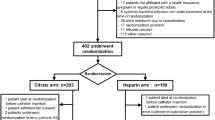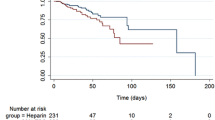Abstract
Catheter coatings have the potential to decrease infection and thrombosis in patients with chronic dialysis catheters. We report our midterm experience with a heparin-coated dialysis catheter. This retrospective, case-control study was approved by our Institutional Review Board. A total of 88 tunneled dialysis catheters were inserted over a 13-month period via the internal jugular vein. Thirty-eight uncoated split-tip catheters and 50 heparin-coated catheters were inserted. Primary catheter patency was compared between the two groups using the log rank test, with infection and/or thrombosis considered as catheter failures. Dialysis parameters during the first and last dialysis sessions, including pump speed, actual blood flow, and arterial port pressures, were compared using unpaired t-tests. Primary patency of the uncoated catheters was 86.0 ± 6.5% at 30 days and 76.1 ± 8.9% at 90 days. Primary patency of heparin-coated catheters was 92.0 ± 6.2% at 30 days and 81.6 ± 8.0% at 90 days (p = 0.87, log rank test). Infection requiring catheter removal occurred in four patients with uncoated catheters and two patients with heparin-coated catheters (p = 0.23). Catheter thrombosis requiring catheter replacement or thrombolysis occurred in one patient with an uncoated catheter and two patients with heparin-coated catheters (p = 0.9). No differences in catheter function during hemodialysis were seen between the two groups. In conclusion, the heparin-coated catheter did not show a significantly longer patency compared to the uncoated catheter. The flow characteristics of this device were comparable to those of the conventional uncoated catheter. A demonstrable benefit of the heparin-coated catheter in randomized trials is needed before a recommendation for routine implementation can be made.

Similar content being viewed by others
References
Raad II, Luna M, Khalil SA, Costerton JW, Lam C, Bodey GP (1994) The relationship between the thrombotic and infectious complications of central venous catheters. JAMA 271(13):1014–1016
CDC (2006) Update: delayed onset Pseudomonas fluorescens bloodstream infections after exposure to contaminated heparin flush—Michigan and South Dakota, 2005–2006. MMWR 55(35):961–963
Silberzweig JE, Sacks D, Khorsandi AS, Bakal CW (2003) Reporting standards for central venous access. J Vasc Interv Radiol 14:S443–S452
Polkinghorne KR, McDonald SP, Atkins RC, Kerr PG (2004) Vascular access and all-cause mortality: a propensity score analysis. J Am Soc Nephrol 15(2):477–486
United States Renal Data System (2008) United States Renal Data System 2008 annual data review, Fig. 5–25. Available at: http://usrds.org. Accessed 25 Nov 2008
Mehall JR, Saltzman DA, Jackson RJ, Smith SD (2002) Fibrin sheath enhances central venous catheter infection. Crit Care Med 30(4):908–912
Trerotola SO, Johnson MS, Shah H et al (1998) Tunneled hemodialysis catheters: use of a silver-coated catheter for prevention of infection—a randomized study. Radiology 207(2):491–496
Maki DG, Stolz SM, Wheeler S, Mermel LA (1997) Prevention of central venous catheter-related bloodstream infection by use of an antiseptic-impregnated catheter. A randomized, controlled trial. Ann Intern Med 127(4):257–266
Hanna H, Benjamin R, Chatzinikolaou I et al (2004) Long-term silicone central venous catheters impregnated with minocycline and rifampin decrease rates of catheter-related bloodstream infection in cancer patients: a prospective randomized clinical trial. J Clin Oncol 22(15):3163–3171
Long DA, Coulthard MG (2006) Effect of heparin-bonded central venous catheters on the incidence of catheter-related thrombosis and infection in children and adults. Anaesth Intensive Care 34(4):481–484
Abdelkefi A, Achour W, Ben Othman T et al (2007) Use of heparin-coated central venous lines to prevent catheter-related bloodstream infection. J Support Oncol 5(6):273–278
Rosenberg RD, Damus PS (1973) The purification and mechanism of action of human antithrombin-heparin cofactor. J Biol Chem 248(18):6490–6505
Rosenberg RD, Armand G, Lam L (1978) Structure-function relationships of heparin species. Proc Natl Acad Sci USA 75(7):3065–3069
Author information
Authors and Affiliations
Corresponding author
Rights and permissions
About this article
Cite this article
Clark, T.W.I., Jacobs, D., Charles, H.W. et al. Comparison of Heparin-Coated and Conventional Split-Tip Hemodialysis Catheters. Cardiovasc Intervent Radiol 32, 703–706 (2009). https://doi.org/10.1007/s00270-009-9608-5
Received:
Revised:
Accepted:
Published:
Issue Date:
DOI: https://doi.org/10.1007/s00270-009-9608-5




